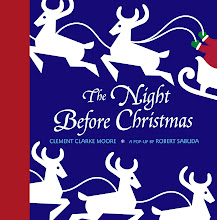 Sabuda's inspiration for his first pop-up adaptation of Frank L. Baum's The Wizard of Oz, came from his early pop-up experiments as a child. According to New York Times writer Chris Hedges, who wrote about Sabuda in his article “Public Lives; In Him, Storyteller Meets Architect,” Sabuda’s first attempt at making his own pop-up was unsuccessful: “’I made my first pop-up book when I was 9,’ [Sabuda] said. ‘It was ‘The Wizard of Oz.’ I spent weeks on it. I couldn’t get the cyclone to spin around’” (2). As an adult, however, Sabuda did get the cyclone to spin -- in spectacular fashion. It is the first pop-up image in his pop-up adaptation of The Wizard of Oz that came out in 2000, and its whirling effect cannot help but induce amazement in his readers. In fact, the book's unique look and intricately engineered pop-ups quickly caught the attention of the public and put the book on the New York Times bestseller list, a rare feat for a Children's book, and especially a pop-up book.
Sabuda's inspiration for his first pop-up adaptation of Frank L. Baum's The Wizard of Oz, came from his early pop-up experiments as a child. According to New York Times writer Chris Hedges, who wrote about Sabuda in his article “Public Lives; In Him, Storyteller Meets Architect,” Sabuda’s first attempt at making his own pop-up was unsuccessful: “’I made my first pop-up book when I was 9,’ [Sabuda] said. ‘It was ‘The Wizard of Oz.’ I spent weeks on it. I couldn’t get the cyclone to spin around’” (2). As an adult, however, Sabuda did get the cyclone to spin -- in spectacular fashion. It is the first pop-up image in his pop-up adaptation of The Wizard of Oz that came out in 2000, and its whirling effect cannot help but induce amazement in his readers. In fact, the book's unique look and intricately engineered pop-ups quickly caught the attention of the public and put the book on the New York Times bestseller list, a rare feat for a Children's book, and especially a pop-up book.Some of the most eye-catching spreads include not just the spinning cyclone, but also an elaborately designed Emerald City and a reconstruction of the wizard's hot-air balloon, which pops up and spins in the gutter of the double-page spread and even shows the basket hanging down from the balloon with the wizard standing inside.
The book was so sophisticated in its look and engineering, it even caught the attention of adults. In her article "Boing! Pop-Up Books Are Growing Up; Flaps, Foldouts and Complexities Attract Adult Eyes," New York Times writer Doreen Carvajal talks about the book's appeal to older audiences: "pull-tabs and double wheels are moving frenetically to attract grown-ups" (1). She goes on to explain in detail the book's unusual engineering and the attraction that engineering has for adults as well children, even going so far as to call Sabuda's works "paper sculptures": "Sabuda has designed a kinetic book of iridescent paper sculptures that shifts from a whirling tornado to a floating hot-air balloon and a byzantine Emerald City castle of towers and cupolas that spreads across two pages. A pair of green spectacles is helpfully tucked away in a side pocket for the reader" (2). The green spectacles are just one example of Sabuda's child-like design sense, which kids love, and adults appreciate because it makes them feel like a kid again. By putting on the spectacles, the already spectacularly designed Emerald City pop-up, looks as though it is completely shrouded in green.
To see a video of the inside of the Wizard of Oz on youtube: http://www.youtube.com/watch?v=T2CI8wuvw4o
Photo credit: http://www.nccil.org







